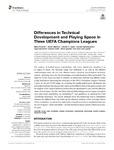Mostrar o rexistro simple do ítem
Differences in Technical Development and Playing Space in Three UEFA Champions Leagues
| dc.contributor.author | Amatria, Mario | |
| dc.contributor.author | Maneiro, Rubén | |
| dc.contributor.author | Casal, Claudio Alberto | |
| dc.contributor.author | Papadopoulou, Sophia | |
| dc.contributor.author | Sarmento, Hugo | |
| dc.contributor.author | Ardá Suárez, Antonio | |
| dc.contributor.author | Iglesias, Xavier | |
| dc.contributor.author | Losada, J.L. | |
| dc.date.accessioned | 2022-03-08T16:40:28Z | |
| dc.date.available | 2022-03-08T16:40:28Z | |
| dc.date.issued | 2021-08-12 | |
| dc.identifier.citation | Amatria M, Maneiro R, Casal CA, Papadopoulou S, Sarmento H, Ardá A, Iglesias X and Losada JL (2021) Differences in Technical Development and Playing Space in Three UEFA Champions Leagues. Front. Psychol. 12:695853. doi: 10.3389/fpsyg.2021.695853 | es_ES |
| dc.identifier.issn | 1664-1078 | |
| dc.identifier.uri | http://hdl.handle.net/2183/29910 | |
| dc.description.abstract | [Abstract] The analysis of football grows exponentially, with many researchers adopting it as an object of study. The thematic range that addresses it, as well as the different methodologies used, are of a very different nature—physical, psychological, technical, tactical—enriching every day the knowledge, and understanding of the game itself. The objective of this study has been to identify the differences between the different styles of play that lead to becoming the champion of the UEFA Champions League in the last 3 years of the pre-COVID stage, by analyzing the spatial performance developed, the association between the players that make up the different lines of the game system and the analysis of the various technical actions that are developed to carry out the offensive phase of each team. For this, the Observational Methodology and two types of analysis have been used: quantitative, by calculating X2, and qualitative, by applying the Polar Coordinates technique. The results obtained show the relationship that is established between the different lines that make up the offensive systems of the champion teams of this competition, as well as the relationship of significance that is established between the use of space—width and depth—and the technical means used to achieve success, the goal. | es_ES |
| dc.description.sponsorship | The authors gratefully acknowledge the support of a Spanish Government subproject Mixed method approach on performance analysis (in training and competition) in elite and academy sport (PGC2018-098742-B-C33) (Ministerio de Ciencia, Innovación y Universidades, Programa Estatal de Generación de Conocimiento y Fortalecimiento Científico y Tecnológico del Sistema I+D+i), that is part of the coordinated project New approach of research in physical activity and sport from mixed methods perspective (NARPAS_MM) (SPGC201800 × 098742CV0) | |
| dc.language.iso | eng | es_ES |
| dc.publisher | Frontiers Research Foundation | es_ES |
| dc.relation | info:eu-repo/grantAgreement/AEI/Plan Estatal de Investigación Científica y Técnica y de Innovación 2017-2020/PGC2018-098742-B-C33/ES/ENFOQUE DE METODO MIXTO EN EL ANALISIS DE RENDIMIENTO (EN ENTRENAMIENTO Y COMPETICION) EN EL DEPORTE DE ELITE Y ACADEMIA/ | |
| dc.relation.uri | https://doi.org/10.3389/fpsyg.2021.695853 | es_ES |
| dc.rights | Atribución 4.0 Internacional | es_ES |
| dc.rights.uri | http://creativecommons.org/licenses/by/4.0/ | * |
| dc.subject | Soccer | es_ES |
| dc.subject | Polar coordinates | es_ES |
| dc.subject | Analysis performance | es_ES |
| dc.subject | Observational methodology | es_ES |
| dc.subject | Density of players | es_ES |
| dc.subject | Orientation change | es_ES |
| dc.subject | Fútbol | es_ES |
| dc.subject | Coordenadas polares | es_ES |
| dc.subject | Rendemento da analise | es_ES |
| dc.subject | Metodoloxía de observación | es_ES |
| dc.subject | Densidade de xogadores | es_ES |
| dc.subject | Cambio de orientación | es_ES |
| dc.title | Differences in Technical Development and Playing Space in Three UEFA Champions Leagues | es_ES |
| dc.type | info:eu-repo/semantics/article | es_ES |
| dc.rights.access | info:eu-repo/semantics/openAccess | es_ES |
| UDC.journalTitle | Frontiers in Psychology | es_ES |
| UDC.volume | 12 | es_ES |
Ficheiros no ítem
Este ítem aparece na(s) seguinte(s) colección(s)
-
GI-PHG - Artigos [118]






